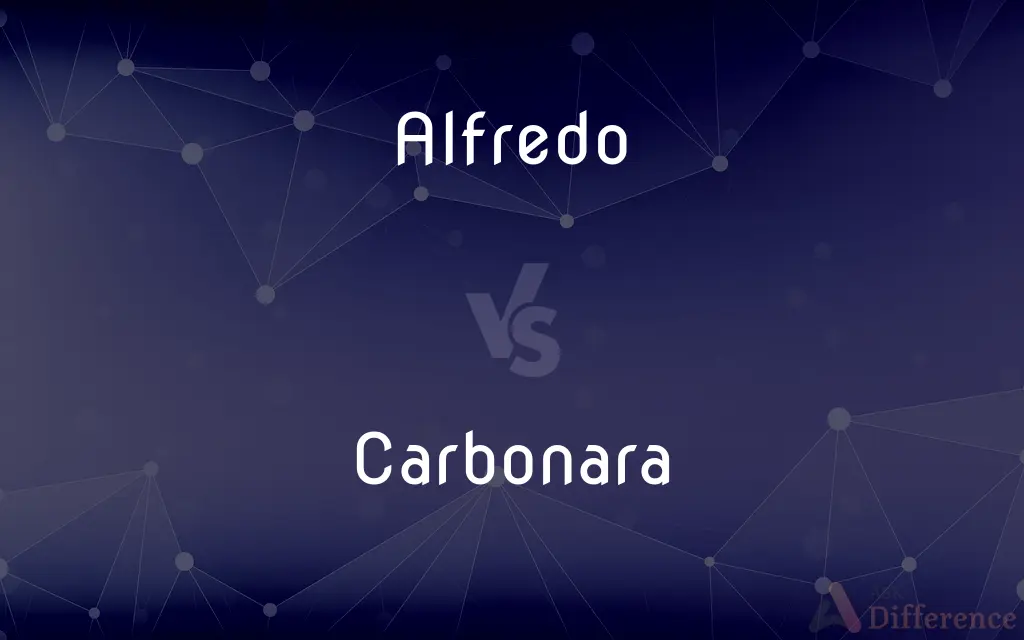Alfredo vs. Carbonara — What's the Difference?
By Fiza Rafique & Maham Liaqat — Updated on March 21, 2024
Alfredo is a creamy, butter-and-cheese-based sauce often used with fettuccine, while Carbonara features a rich blend of eggs, cheese, pancetta, and pepper, typically served with spaghetti.

Difference Between Alfredo and Carbonara
Table of Contents
ADVERTISEMENT
Key Differences
Alfredo sauce is characterized by its creamy texture and rich flavors of butter, heavy cream, and Parmesan cheese. This combination creates a smooth, velvety sauce that clings to pasta, such as fettuccine, providing a decadent dish. On the other hand, Carbonara sauce boasts a unique creaminess from eggs mixed with grated Pecorino Romano or Parmigiano-Reggiano, enriched with pancetta or guanciale, and seasoned with black pepper. The heat of the cooked pasta is used to softly cook the egg mixture, ensuring the sauce is silky and coats the pasta like spaghetti without curdling.
Originating from Rome, Carbonara is a testament to Italian culinary simplicity, emphasizing the quality of its few ingredients. It's a dish that balances the richness of the egg and cheese with the savory depth of pancetta, rounded off with a spicy kick from freshly ground black pepper. Alfredo, while also Italian, has gained more popularity abroad, especially in American Italian cuisine, where its creamy sauce is a comforting favorite. The sauce's origins are more modern, with its creation attributed to Alfredo di Lelio in Rome during the early 20th century, whereas Carbonara's history is more deeply rooted in Italian culture, with debated origins but undeniable staying power in Roman cuisine.
When it comes to texture, Alfredo's sauce is smooth and uniform, relying on the melding of cream and cheese for its signature consistency. Carbonara, however, relies on the technique of emulsifying the eggs with the fats rendered from the pancetta and the starchy pasta water, creating a sauce that lightly coats the pasta strands. This difference in technique highlights the creamy versus the coated, each providing a distinct eating experience.
In terms of serving, Alfredo is traditionally served with fettuccine, known as Fettuccine Alfredo, highlighting the way the thick, flat pasta ribbons perfectly capture the creamy sauce. Carbonara, traditionally served with spaghetti, takes advantage of the pasta's shape to evenly distribute the sauce, ensuring a balanced mix of sauce, pasta, and pancetta in every bite. This choice of pasta shapes underscores the intended experience of each sauce, with Alfredo aiming for richness and Carbonara for a balance of flavors and textures.
Despite their differences, both Alfredo and Carbonara have garnered worldwide popularity, each adapted in various ways outside of their traditional recipes. Alfredo has seen variations that include additions like chicken and broccoli, while Carbonara has been subject to numerous adaptations, sometimes controversially including cream. These adaptations reflect the global love for these dishes, while also highlighting the versatility of Italian pasta sauces.
ADVERTISEMENT
Comparison Chart
Base Ingredients
Butter, heavy cream, Parmesan
Eggs, Pecorino Romano/Parmesan, pancetta/guanciale
Texture
Creamy and smooth
Silky and coats the pasta
Traditional Pasta
Fettuccine
Spaghetti
Origin
Rome, early 20th century
Rome, origins debated
Flavor Profile
Rich, buttery, cheesy
Rich, savory, with a hint of pepper
Technique
Simmering cream and cheese
Emulsifying eggs with pasta water and fats
Popular Variations
Chicken Alfredo, Broccoli Alfredo
Carbonara with cream, vegetarian versions
Cultural Perception
American-Italian favorite
Staple of Roman cuisine
Compare with Definitions
Alfredo
Known for its rich and buttery flavor profile.
The secret to a great Alfredo sauce is the quality of the Parmesan cheese used.
Carbonara
Known for its creamy sauce without using cream, achieved through the emulsification of eggs and cheese with pasta water.
The creamy texture of Carbonara comes from the eggs, not cream, making it a unique pasta dish.
Alfredo
Often served as a base for other ingredients like chicken or vegetables.
To add protein to my meal, I like to include grilled chicken in my Alfredo pasta.
Carbonara
Carbonara's flavor is enhanced by the savory taste of pancetta or guanciale.
The key to a flavorful Carbonara sauce is using high-quality pancetta that renders out its fat.
Alfredo
A creamy pasta sauce made with butter, heavy cream, and Parmesan cheese.
I decided to make fettuccine Alfredo for dinner because I craved something rich and comforting.
Carbonara
A dish that exemplifies the simplicity and elegance of Italian cuisine.
Carbonara showcases how simple ingredients can create a profoundly delicious and satisfying meal.
Alfredo
A dish featuring pasta, typically fettuccine, coated in Alfredo sauce.
Fettuccine Alfredo is a popular choice for those who love creamy pasta dishes.
Carbonara
A traditional Italian pasta dish made with eggs, cheese, pancetta, and pepper.
For an authentic Italian dinner, I prepared spaghetti Carbonara, following a recipe from Rome.
Alfredo
Originating from Italy, but popularized in American Italian cuisine.
Alfredo sauce, while Italian, has become a staple in American Italian restaurants.
Carbonara
Often made with spaghetti, but can also be served with other pasta shapes.
While traditional Carbonara uses spaghetti, I experimented with rigatoni to capture more sauce in each bite.
Alfredo
Being or served with a sauce containing cream, Parmesan cheese, and butter
Fettuccine Alfredo.
Carbonara
Carbonara (Italian: [karboˈnaːra]) is an Italian pasta dish from Rome made with egg, hard cheese, cured pork, and black pepper. The dish arrived at its modern form, with its current name, in the middle of the 20th century.The cheese is usually Pecorino Romano, Parmigiano-Reggiano, or a combination of the two.
Alfredo
(cooking) Alfredo
Carbonara
Being or served with a sauce of eggs, minced bacon or ham, grated cheese, and seasonings
Spaghetti carbonara.
Carbonara
Carbonara sauce.
Carbonara
A thick Italian pasta sauce, made with guanciale, grated cheese, beaten egg yolks and pepper.
Carbonara
(by extension) A spaghetti dish made using such a sauce.
Carbonara
A spaghetti dish made using a similar sauce made from a different type of cured pork than guanciale (such as bacon, pancetta, lardons, gammon or ham).
Carbonara
Sauce for pasta; contains eggs and bacon or ham and grated cheese
Common Curiosities
What pasta is best served with Alfredo?
Fettuccine is traditionally served with Alfredo sauce because its flat and wide shape holds the creamy sauce well.
Is Alfredo sauce considered healthy?
Due to its high content of butter and cream, Alfredo sauce is rich in calories and fat, making it less suitable for a healthy diet.
What is Alfredo sauce made of?
Alfredo sauce is made with butter, heavy cream, and Parmesan cheese.
What's the difference between Alfredo and Carbonara?
Alfredo is a creamy sauce made with butter and cheese, whereas Carbonara is made with eggs, cheese, and pancetta, offering different textures and flavors.
Why doesn't Carbonara use cream?
Traditional Carbonara relies on the creaminess of eggs and cheese instead of cream, which is considered a key characteristic of the dish.
Is Carbonara spicy?
Carbonara is not typically spicy, but it is seasoned with black pepper, which adds a warm, aromatic kick to the dish.
How do you make Carbonara sauce creamy?
Carbonara sauce becomes creamy through the emulsification of eggs and cheese with the hot pasta and a bit of reserved pasta water.
Can I use bacon instead of pancetta in Carbonara?
While not traditional, bacon can be used as a substitute for pancetta in Carbonara for a similar smoky flavor.
How can I prevent my Carbonara sauce from scrambling?
To prevent the eggs from scrambling, mix them with the cheese off the heat and quickly combine with the hot pasta, using a bit of pasta water to adjust consistency.
Can I add chicken to a Carbonara?
While not traditional, adding chicken to Carbonara can provide extra protein, adapting the dish to personal taste preferences.
Can Alfredo sauce be frozen for later use?
Alfredo sauce can be frozen, but it may separate when thawed. Gently reheating and whisking can help restore its creamy texture.
Can Alfredo sauce be made without cream?
While heavy cream is traditional, some recipes use milk and a roux to achieve a lighter version of Alfredo sauce.
Is there a vegetarian version of Carbonara?
Yes, vegetarian Carbonara can be made by substituting the pancetta with mushrooms or zucchini for a similar texture without the meat.
Why is my Alfredo sauce sometimes grainy?
Alfredo sauce can become grainy if the cheese is added too quickly or at too high a temperature, causing it to separate rather than melt smoothly.
What cheeses can be used in Carbonara?
Traditional Carbonara uses Pecorino Romano or Parmigiano-Reggiano, but variations may include a mix of both for a balanced flavor.
Share Your Discovery

Previous Comparison
Accessory vs. Accessary
Next Comparison
Sale vs. ConsignmentAuthor Spotlight
Written by
Fiza RafiqueFiza Rafique is a skilled content writer at AskDifference.com, where she meticulously refines and enhances written pieces. Drawing from her vast editorial expertise, Fiza ensures clarity, accuracy, and precision in every article. Passionate about language, she continually seeks to elevate the quality of content for readers worldwide.
Co-written by
Maham Liaqat













































